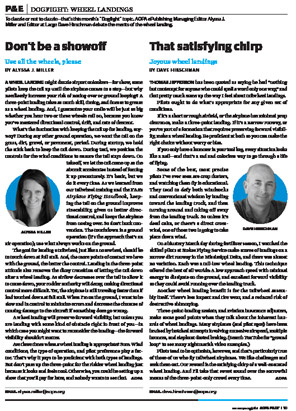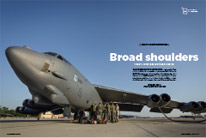Dogfight: Wheel Landings
 Looks like the long-running debate among tailwheel pilots on the merits of three-point versus wheel landings is still unresolved.
Looks like the long-running debate among tailwheel pilots on the merits of three-point versus wheel landings is still unresolved.
I enjoyed the “Dogfight” discussion on wheel versus three-point landings in the May issue. I think, however, Dave Hirschman missed an important point. Instability on the ground depends largely on how far the center of gravity is aft of the main landing gear in a taildragger. When the fuselage is level, as during a wheel landing, the geometry of the aircraft moves the CG forward, effectively reducing the aircraft’s instability.
So if you are doing a wheel landing, you get increased control because of the greater airspeed (control authority varies with the square of your airspeed) and the fact that the tail is not buried in the turbulent wake of the fuselage. The aircraft is less unstable and you get good authority from the brakes because the wheels are firmly planted on the ground. Besides, wheel landings are excellent precision flying practice.
Vaughan Askue
AOPA 305333
Stratford, Connecticut
Having learned to fly in a J–3 and now as the proud owner of a Cessna 140, I was amused at the Dogfight comments. At first, I thought Alyssa Miller’s comments were from someone uninitiated in the wonderful world of tailwheel airplanes. But by reading further, I realized that she was knowledgeable on the subject and no doubt has a tailwheel endorsement, along with some experience. About the only thing I take exception to is her notion that somehow wheel landings are “showing off” or “hot dogging” in front of onlookers.
I was taught “three-point, full stall, every time, no matter what.” The first wheel landing I ever attempted was in my dad’s 170B during my checkride, when the examiner asked me to demonstrate one. Since then, I’ve learned how to do wheel landings and have instructed others how to do them.
Our chief pilot has about 6,000 hours in an Ag Cat and he says, “tailwheels are not meant to be landed on. If you do, you’ll be working on them all the time.” He also says that tailwheel pilots usually make what he calls “homogenized” landings, the kind of tail-low wheel landings that Dave Hirschman described. I enjoyed reading both sides of the argument—real pilots fly real airplanes. And real airplanes have a small wheel on the tail.
T. L. (Ted) Colvin Jr.
AOPA 6159474
West Monroe, Louisiana
“In the end, Dave and I both agree that pilots need to feel comfortable with both types of landings and do what works best for the aircraft and type of operation. I own a Cessna 170B and my father is also a 170 pilot, and he does wheel landings. I gave him a heads up about the article and asked him to not disown me!”
Alyssa J. Miller
“I’ve personally seen Alyssa make beautiful three-point and wheel landings, and I can attest to her skill at both. Her strong preference for three-point landings is as confounding to me as pilots who insist on north-up map orientation (instead of track up), but that’s another argument I’ll never win.”
Dave Hirschman
Nothing remotely like it
AOPA’s recent article “Nothing Remotely Like It” is a welcomed description of flying the Idaho backcountry, an experience unique to most pilots, requiring additional education and skill. As the Idaho Division of Aeronautics safety/education coordinator, I encourage visiting pilots to access the valuable resources available on our website—specifically, a list of backcountry flight instruction opportunities, as well as standard operating procedures for Johnson Creek Airport and our other popular airstrips.
Safety becomes a concern as the number of airplanes increases, particularly during popular flying events. Comprehensive flight planning and backcountry flight training are necessary for the optimal experience flying in the Idaho backcountry. Thank you for helping us publicize this information critical for safety. The link for the standard operating procedures is on our website. We are proud to be the first state to offer a complimentary Airports App with links to these SOPs and other vital flight information. I hope to see many more articles like this one, highlighting the smaller, less familiar aviation events in the western United States.
Santiago Guerricabeitia
AOPA 2590303
Boise, Idaho
Broad shoulders
 Really! Is there anything left for Barry Schiff to fly? I once sat in the cockpit of a B–47. Talk about “strapping on wings.” Schiff’s article reminded me of a conversation I eavesdropped on between a Cherokee pilot and air traffic control at Westover Air Force Base in Chicopee, Massachusetts. Westover was a major SAC base back in the day (it hosts a C–5 wing now). The Cherokee pilot had flown B–52s out of the base. ATC was impressed and asked which bird he preferred, the BUFF or the GA aircraft. The guy answered immediately. “The Cherokee, the B–52 was no fun to fly!” Glad Barry had the chance. Someday, I hope someone resuscitates a B–36 for him. P.S. That control panel could use a good cleaning!
Really! Is there anything left for Barry Schiff to fly? I once sat in the cockpit of a B–47. Talk about “strapping on wings.” Schiff’s article reminded me of a conversation I eavesdropped on between a Cherokee pilot and air traffic control at Westover Air Force Base in Chicopee, Massachusetts. Westover was a major SAC base back in the day (it hosts a C–5 wing now). The Cherokee pilot had flown B–52s out of the base. ATC was impressed and asked which bird he preferred, the BUFF or the GA aircraft. The guy answered immediately. “The Cherokee, the B–52 was no fun to fly!” Glad Barry had the chance. Someday, I hope someone resuscitates a B–36 for him. P.S. That control panel could use a good cleaning!
Daniel A. Brown
AOPA 1309660
Taos, New Mexico
Air Force role model What an outstanding aviation magazine. Somehow you manage to fill every copy with relevant and interesting aviation articles that satisfy the broad range of pilots out there today, and your May issue is no different. However, in “Pilot Briefing,” you highlight the accomplishment of Lt. Col. Merryl Tengesdal being promoted to colonel.
Merryl is the first black female U–2 pilot. There have been other black pilots who flew the U–2 before Merryl, and Col. Soren Jones (a black U–2 pilot many years before Merryl) was not only promoted to full colonel after having already served as a U-2 squadron commander and deputy operations group commander of the U–2 Group, but was also given command of the operations group that supported U–2 operations in the Middle East. I celebrate Merryl’s accomplishment (she deserved it and is a super person).
Jon Engle
AOPA 1108508
Hollywood, South Carolina
“Barry Schiff’s article in this month’s AOPA Pilot, ‘Flying the B–52’ was outstanding (as usual). It is an informative, well-written military aviation article.”
Mike Banner
AOPA 1281885
Gainesville, Florida
Errata
In “Winnebago On the Water,” May 2015 AOPA Pilot, we incorrectly placed Churchill in Ontario, Canada; it is in Manitoba. Pilot regrets the error.
We welcome your comments. Editor, AOPA Pilot, 421 Aviation Way, Frederick, Maryland 21701 or email ([email protected]). Letters may be edited for length and style before publication.
Hangar Talk
AOPA Pilot Editor at Large Dave Hirschman has flown many impractical pylon racers and sport aerobats, and he never considered that experience relevant to someday flying a jet. But when Sonex Aircraft sought an aviation writer to evaluate its single-seat JSX–2, Hirschman’s experience in tiny, quick airplanes turned out to be a plus. “I’ve always regarded my enthusiasm for Pitts biplanes and Cassutt racers as a character flaw,” he says. “But this time, it actually worked in my favor.” Hirschman and AOPA Senior Photographer Mike Fizer traveled to Moriarty, New Mexico, for a close look at a unique, glider-based training program designed for aspiring jet pilots (see “Having a Blast,” page 50). Hirschman came away with an LOA and insights into the possibilities brought about by a new breed of sport jet. “Flying the JSX–2 is a scream,” he says. “It’s intoxicating, and it’s easy to imagine flying clubs and partnerships being formed around this exciting new aircraft.”


